| Back to Back Issues Page |
 |
|
July 2014 Trail Bytes: Inca Stew, Dehydrating Quinoa and Sweet Potatoes July 22, 2014 |
| Hello, What kind of food is considered “good eating” at 7,970 feet? For the Inca civilization, two important crops were quinoa and sweet potatoes. Both of these crops were first cultivated several thousand years ago in the Andean region of South America. Machu Picchu, an Inca site situated at 2,430 meters (7,970 feet) above sea level, was constructed in the mid-15th century at the height of the Inca Empire. Quinoa was a hardy plant that grew well in the mountains where temperatures during the growing season could dip below freezing at night and rise to near 100° F during the day. Sweet potatoes grew well at the lower elevations. The harvested quinoa seeds and sweet potatoes stored well, providing a secure and reliable food source that enabled the Inca Empire to thrive until the Spanish Conquest in the mid-16th century. Quinoa and sweet potatoes are very nutritious. The edible seeds of the quinoa plant are high in protein, fiber, phosphorus, magnesium, iron and calcium. Sweet potatoes are high in complex carbohydrate, fiber, beta-carotene (Vitamin A), Vitamin C, calcium, folate and potassium. Sweet potatoes also contain antioxidant and anti-inflammatory nutrients. With all of these health benefits, quinoa and sweet potatoes top the list of backpacking “super foods,” so this month we put them together for a tasty Inca Stew. 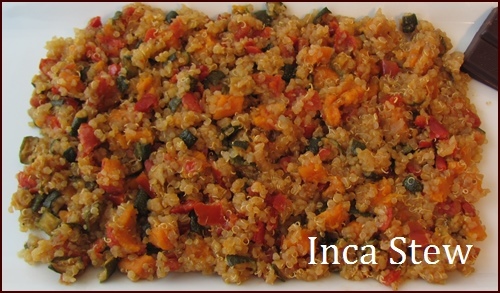
Inca StewServes 1Ingredients: ½ Cup Precooked and Dried Quinoa ½ Cup Dried Vegetables (any kind) ¼ Cup Precooked and Dried Diced Sweet Potatoes 1¼ Cups Water to rehydrate 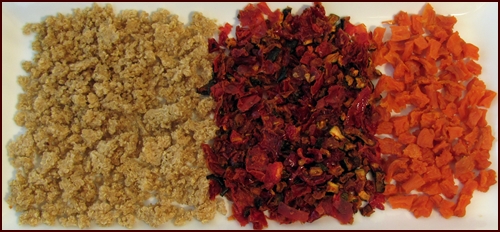
Notes: Since these food ingredients can stand on their own, I didn't add any special seasoning to the recipe other than cooking the quinoa with an all-natural bouillon cube and cooking the vegetables with a pinch of Italian herbs. For vegetables, I cooked and dried a simple ratatouille consisting of diced zucchini, red bell pepper, onion, tomato and garlic – but any one or combination of your favorite dried vegetables would work. Although I could have added the cooked quinoa to the stew and dried it combined, I dried the quinoa separately so that I could use it in other recipes as an alternative to rice. Quinoa behaves just like precooked and dried rice in backpacking meals and rehydrates well. Cook on the trail in the usual way: Soak ingredients in pot with water for five minutes, light stove and bring to a boil for one minute, turn off stove and let sit ten minutes. Alternatively, this meal could be cooked by adding hot water to the food in a container and letting it sit for fifteen to twenty minutes in a cozy. Cooking & Drying Quinoa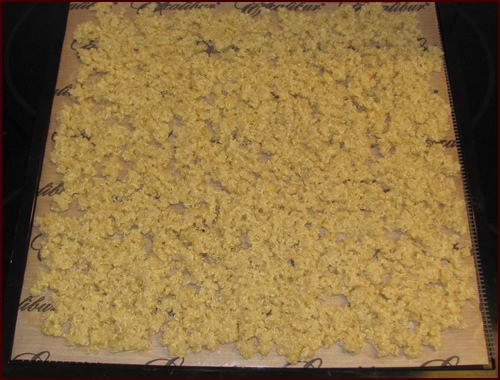
1. Rinse quinoa several times by pouring water over the seeds in the pot. The seeds sink to the bottom making it easy to pour off the water. Quinoa has a bitter-tasting coating called saponin which is mostly removed in commercially available quinoa, but rinse just in case. 2. Combine one cup quinoa with two cups liquid such as bouillon seasoned water or broth. Plain water may be used. Add ¼ tsp salt. 3. Bring to a boil and then reduce to lowest temperature for about twenty minutes with pot covered. 4. Spread on covered dehydrator tray and dehydrate at 135°F for 8 – 12 hours. One cup of quinoa will fit on one Excalibur tray after cooking. Break into smaller pieces when close to dry. Notes: Use dried quinoa in place of or in combination with rice in any of the recipes in Recipes for Adventure. Because of its high protein content, it is an excellent choice for meatless entrees. Dried quinoa can be eaten dry as a crunchy and slightly nutty-tasting ingredient in homemade trail mix. Baking & Drying Sweet Potatoes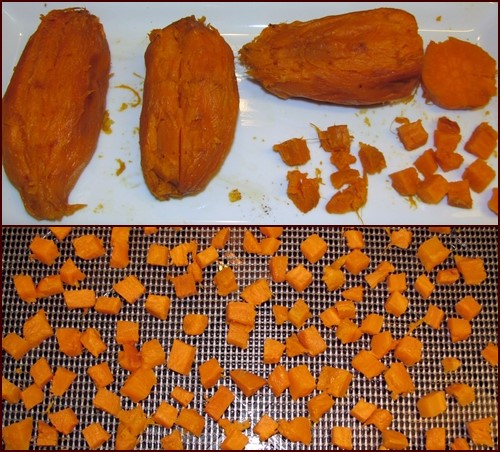
1. Place several medium sweet potatoes in oven preheated to 375° F (190° C) and bake for fifty minutes or a little longer for larger potatoes. Poke a few holes in top of potatoes with a fork and use a cookie sheet under the potatoes since some juices will run out. 2. Remove sweet potatoes from oven, let cool and remove skins. The skins slip right off. I ate the skin of one and it was sweet and delicious. 3. Slice potatoes crosswise about ⅜ to ½ inch thick and then cut the slices into small cubes of the same thickness. If potatoes have gotten too soft, place in the freezer for a few minutes to firm them up for easier cutting. 4. Spread cubed sweet potatoes on dehydrator tray without non-stick sheet and dehydrate at 135° F for 8 – 12 hours. Notes: Dried sweet potato cubes can be eaten dry, but they are a little chewy. I like them that way. Include dried sweet potato cubes as part of a vegetable medley in any of my recipes. They will add color and extra nutrition. Baked sweet potatoes may be used in place of boiled sweet potatoes in the sweet potato bark recipe. Either way works great. 8-Day Backpacking Menu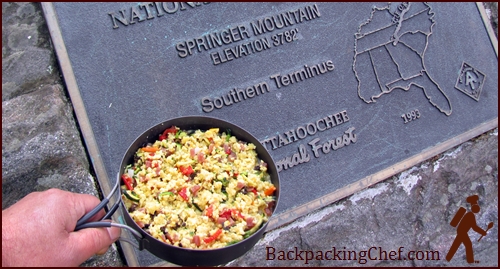
In May I backpacked for eight days on the Appalachian Trail through Georgia. I added a new page with my menu and details about how I dried all the food the week before the hike. Read the 8-Day Backpacking Menu. Until next time, Dominique and I wish you a happy and adventurous summer. We’ll celebrate my birthday later this month with a bicycle ride to Germany from our flat here in Switzerland. I’ll pack a hot lunch that will include dried chicken precooked in my new pressure cooker. More on that next month. Best regards, Chef Glenn & Dominique P.S. If you have any questions or comments about this issue of Trail Bytes, please reply to this email or use the contact form at BackpackingChef.com. |
| Back to Back Issues Page |
